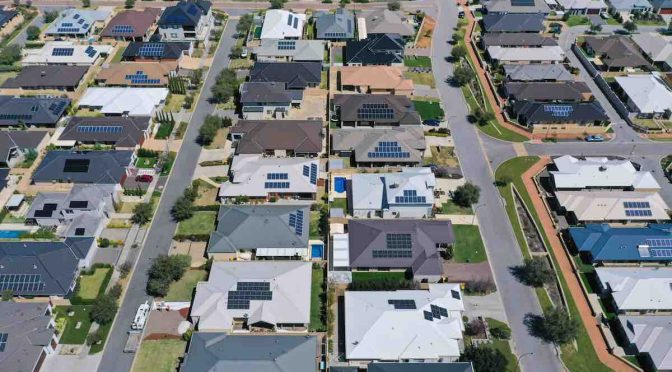Rooftop solar is now the fourth latest source of electricity in Australia, and a major player in the grid that is unparalleled in the rest of the world, but the need to encourage Australians to work with the grid rather than get off it is becoming more urgent.
Residential solar now accounts for 11.2 per cent of Australia’s electricity supply – from more than 20 gigawatts of installed capacity, according to the Clean Energy Council’s (CEC) new Rooftop Solar and Storage Report.
The report shows that New South Wales installed the most rooftop solar capacity last year, at 970 megawatts (MW), but Queensland has the most systems as the total number of rooftop solar arrays in the state ticked over 1 million.
The CEC estimates that one third third of all households and businesses in Australia now have their own array, after 2.9 GW of new capacity installed from 314,507 units was installed in 2023, its second highest total.
And that number is only set to grow, with the Australian Energy Market Operator predicting rooftop solar capacity will nearly quadruple in coming decades. Solar Citizens has identified 45.8 GW of rooftop potential that is yet to be exploited and the Climate Council wants to double rooftop solar capacity bin the next six years to meet 2030 climate goals.
From curtailment to incentives
The CEC says 57,000 batteries were installed by Australian households in 2023, but more needs to be done. The CEC is pushing for various state-based rebates to be replaced by a national Home Battery Saver Program of up to $6500 per household.
“It is clear that now is the time to back home batteries, build on their growing popularity among households and write the next chapter of Australia’s solar success story,” CEC policy director of distributed energy, Con Hristodoulidis says.
The hope by energy players and the market operators is that these batteries can help soak up excess solar, and become part of a manageable grid, many in the form of virtual power plants.
But anecdotal reports from solar battery installers and hard data on virtual power plant (VPP) takeup by the likes of SunWiz show that Australians don’t feel like they’re being brought along for the ride.
It means that regulators and networks will need to start working even harder to figure out how to manage a source of electricity that is largely uncontrolled by the Australian Energy Market Operator (AEMO) and owned by individuals who all have their own motivations for having home energy assets.
“People will need good reasons to hand over control of their solar, batteries and appliances, particularly if they bought expensive equipment such as batteries for back-up power or to increase their energy independence,” wrote a team of researchers led by UNSW associate professor Anna Bruce in The Conversation.
“It would be a major setback to the net zero transition if AEMO and network businesses, lacking better options for managing the grid, continue to cut back and switch off solar systems until people find it unattractive to purchase them.”
Premium feed-in tariffs were the jump start for rooftop solar in Australia, but what followed was a lot of work on curtailment, advanced inverters that help in orchestration, and in some cases emergency kill switches that give AEMO and networks the ability to switch off solar systems as a last resort, Hristodoulidis says.
What needs to come next — and quickly — are incentives and rewards for managing energy demand that show households that regulators and large companies value their energy assets.
‘We haven’t got to the tipping point yet where we’ve lost the community on this, but we need to start moving on work around incentives and rewards with the ability to opt in and out,” he says.
One example of incentives working is the original South Australian Home Battery program, which was ended in 2022, which provided a rebate for home batteries that was heavily promoted as part of the state’s VPP program.
Hristodoulidis says almost three quarters of battery buyers through the scheme also signed up to the VPP, proving that with the right incentives Australians are willing to buy into aggregation and do still have a lot of goodwill towards these kinds of schemes.
Big energy must win the crowd
VPP projects in Western Australia with Project Symphony and Victoria with Project EDGE, which reward households for allowing a retailer or network to manage their home energy assets so they have less impact on the grid or reduce costs, show they can work.
And some networks, such as in South Australia where rooftop solar now occasionally provides all of the electricity needs of the state, are using low “solar soak” rates to push people into using more power during the day, says Bruce and her colleagues.
A decision on the Australian Energy Market Commission’s (AEMC) move to let Australian homes and businesses monetise their own energy assets while giving AEMO move visibility over them is expected on July 11.
But more needs to be done to give small-scale power generators a fair go, effectively putting households on par with other players in the energy market and counting them as energy generators in their own right rather than a threat, said Dr Saul Griffith and Dr Vikki McLeod in February.
Politicians appear to be getting the message: in March, federal ministers committed to reforms through a National Consumer Energy Resources Roadmap to better protect consumers and allow them to export more solar to the grid.
They promised to set up national standards on key technologies such as vehicle-to-grid chargers.
But experts pointed out when the Roadmap was first announced that it’ll take more than planning – which has been promised before – to make the most of what is the now-second largest renewable energy generation source in the country.
Rachel Williamson, reneweconomy.com.au


